Here’s a simple and accessible Giro d’Italia guide. There’s a concise preview of every stage below as well as explainers on the rules for the mountains and points competitions; TV guide and more.
This is a blog post which will drop off the front page in due course but there’s a copycat page which you can reach easily throughout the coming weeks with the menu at the top of the page and the Giro link / for mobile users it’s via the dropdown menu. Or just remember inrng.com/giro.
Route summary

The Giro is always backloaded with mountain stages at the end but this time it’s even more pronounced with an opening phase to delight the sprinters and little climbing until well into the second week. Then the second half over-compensates with a lot of vertical gain, there’s more climbing in this year’s Giro than last year but the summit finishes vary, some are even big ring climbs and the hardest climbing is often mid-stage but there are still some tough, selective finishes. There are three time trials with a total of 59.8km, more than any other race this year, and they’ve all got significant climbs to advantage the GC contenders over the TT specialists.
Now on to each stage. Note the annotations where TV = Traguardo Volante or Intermediate Sprint and R = Rifornimento or Feed Zone.
Stage 1 – Saturday 11 May

An 8km time trial with two parts, first a fast section through the streets of Bologna and then a hill climb to the San Luca basilica, a 1.8km ascent that averages 10.8% and has sustained ramps at 14% and then 16%. Openers like this can help with the hierarchy, this will be a solid test of fitness for the weeks to come.
Stage 2 – Sunday 12 May
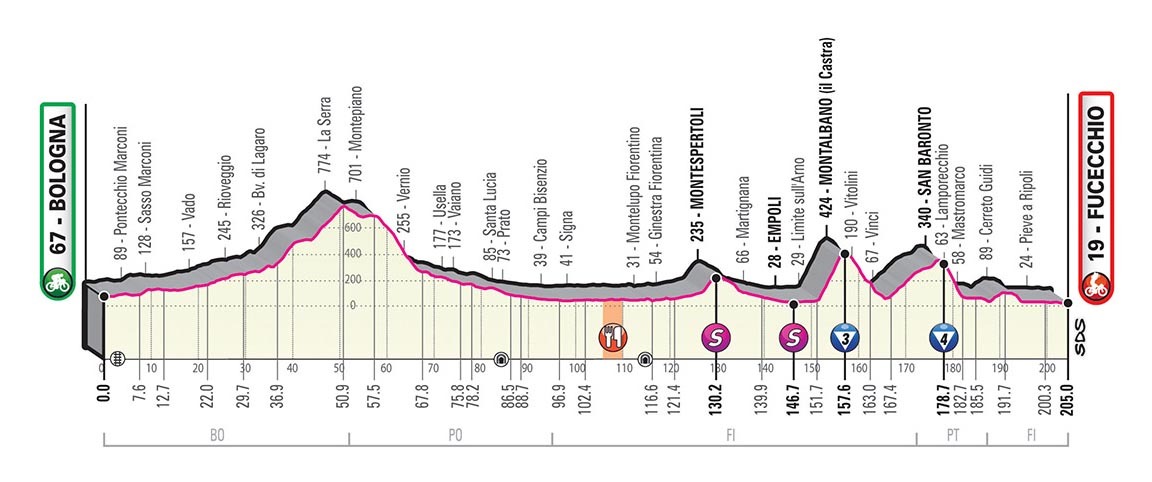
The race traverses the Apennines but this one for the sprinters. The two late climbs will encourage a bit of action for the final 50km as riders jostle for the mountains competition because win at Montalbano and you can hope to keep the jersey for several days. On inspection Montalbano is a 6km climb at 5.8%.
Stage 3 – Monday 13 May

Another one for the sprinters as the race heads south.
Stage 4 – Tuesday 14 May

It wasn’t long ago that the Giro signed a contract to finish in Rome but whether it was last year’s flagstone fiasco or the something internal to the Rome mayoralty which, to be generous, has it challenges, it’s gone and today marks the closest the Giro gets to the capital with a finish in Frascati, home of the DOC wine and like a good vintage there’s a nice finish here with an uphill run through the streets of the town.
Stage 5 – Wednesday 15 May
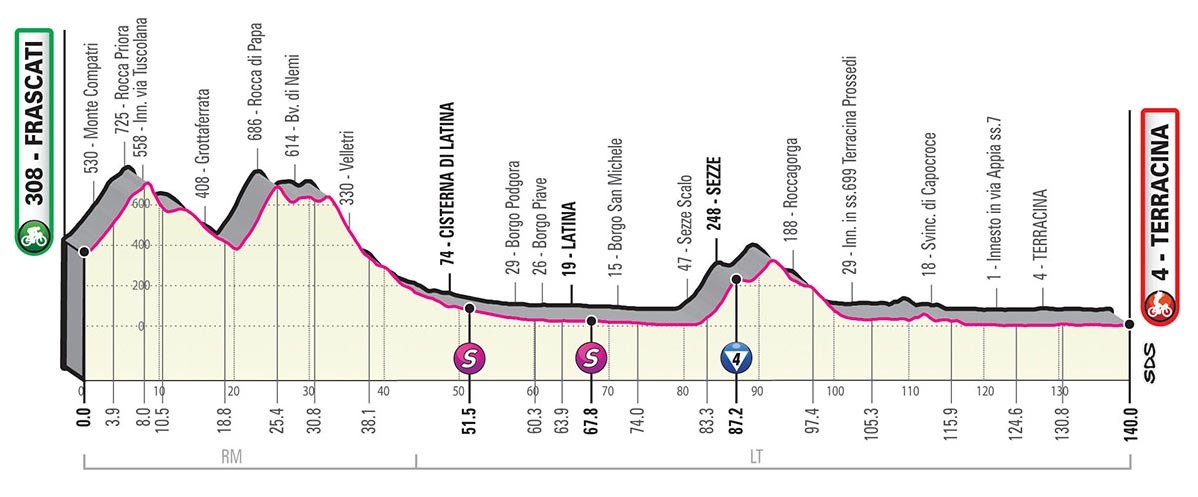
One for the sprinters and a day where you probably shouldn’t set aside hours of viewing but it’s a quick 140km ride.
Stage 6 – Thursday 16 May
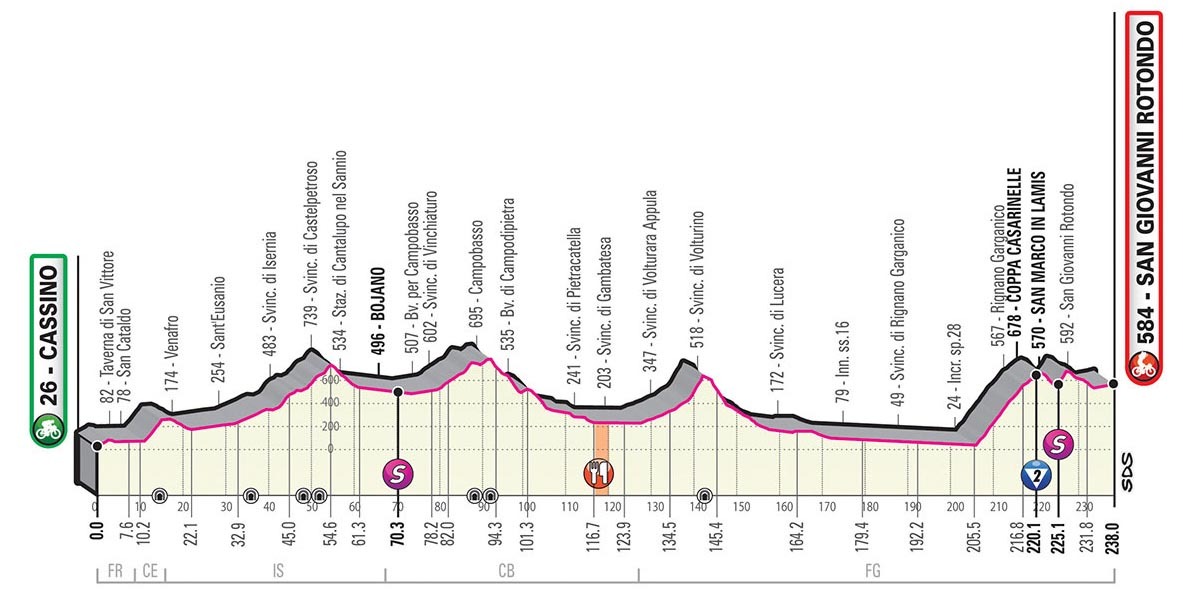
A long day in the saddle at 238km and if the finish has some climbing the main ascent is 15km at a steady 4-5% for the most part and the finish is a gentle uphill slope.
Stage 7 – Friday 17 May
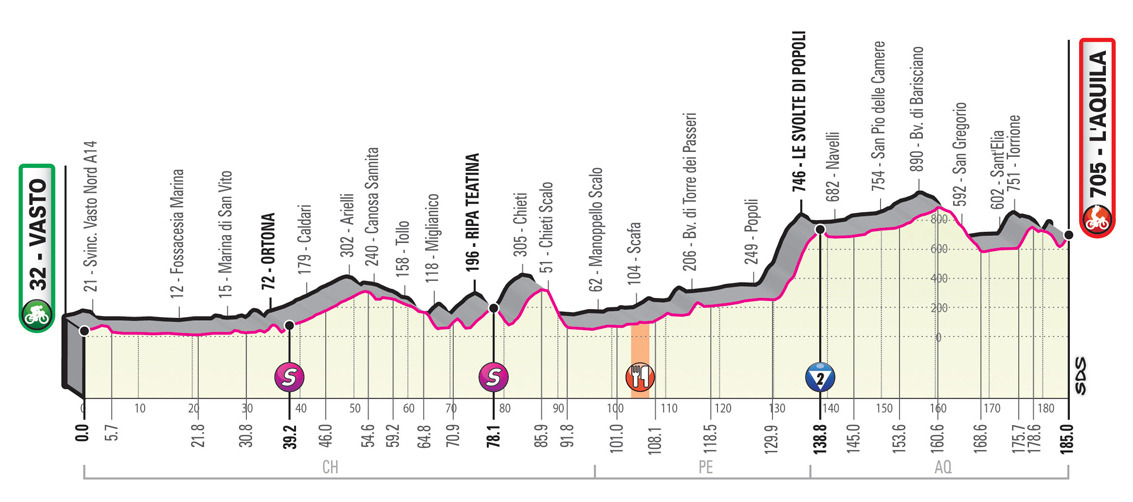
After a brief spin past beaches and numerous gelatiere the race heads inland. The Svolte de Popoli climb is famous for local motorsport and then there’s a lively finish in L’Aquila with sharp ramps.
Stage 8 – Saturday 18 May

Another long day but just maybe the small climbs the final third help to break things up. The roads should be familiar to some in the peloton it’s the same coastal road from Gabbice to Pesaro used in 2013 when Alex Dowsett was the surprise TT winner ahead of Bradley Wiggins.
Stage 9 – Sunday 19 May

A crucial time trial, 34.8km and with some sustained climbing and a total of 900m of vertical gain as the race goes into the microstate of San Marino.
Stage 10 – Tuesday 21 May
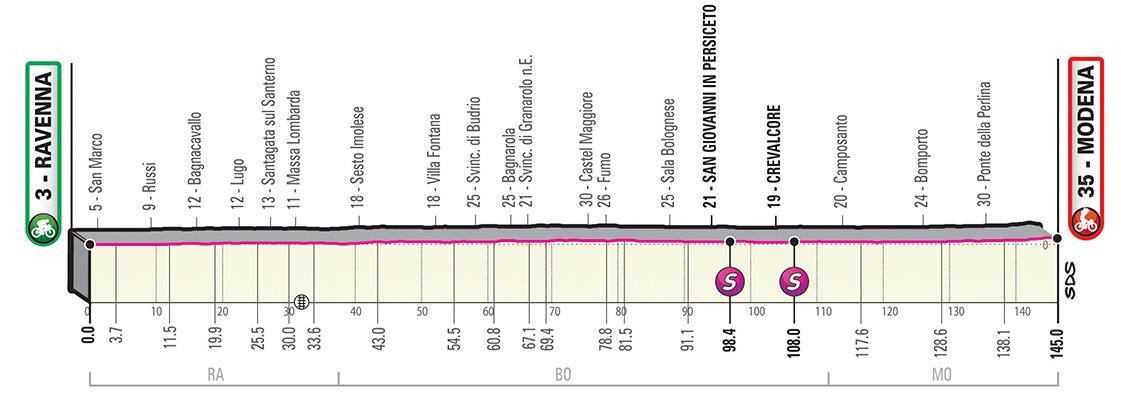
Flat and mercifully just 145km but a gourmet’s delight as the stage runs near to the homeland of many of Italian cooking’s central ingredients.
Stage 11 – Wednesday 22 May
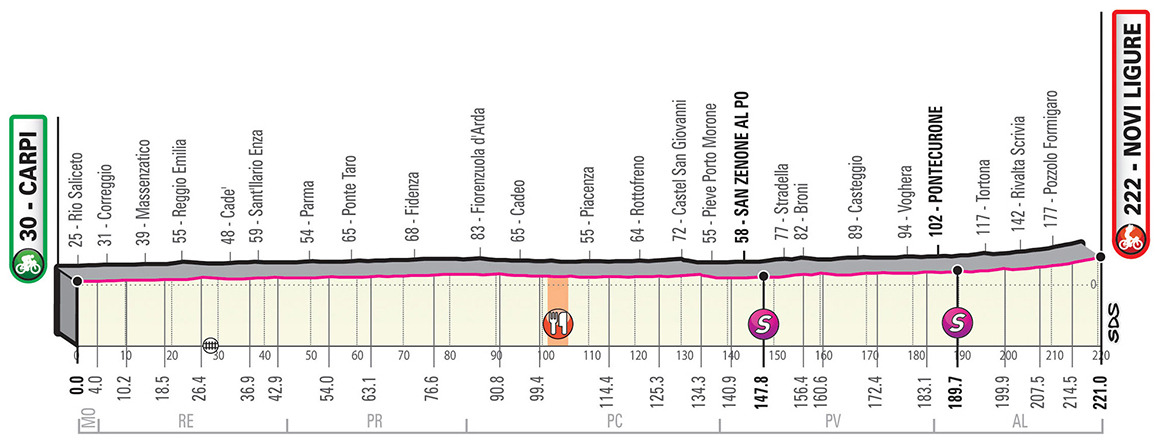
Another chance for the sprinters as the race heads to Novi Ligure, an industrial town that has a cycling museum and links to Fausto Coppi, who as a boy, would deliver groceries on a bike across the region.
Stage 12 – Thursday 23 May
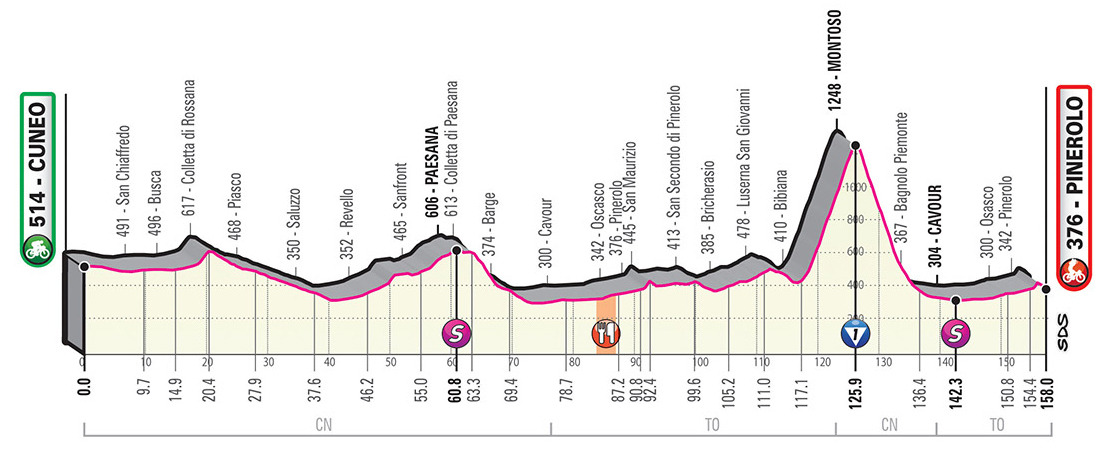
The theme of the Cuneo-Pinerolo stage is Fausto Coppi’s 1949 raid between the two towns although that happened in the Alps, this stage crosses the plains for the most part before the sharp climb to the tiny ski station of Montoso and 9km at 9.5% and most of it over 10% with some sustained 12-14% sections, a selective climb chased by a twisty descent and 20km across the plains to the finish before Pinerolo and if the profile looks flat, watch out for the tricky 20% cobbled “wall” that was used before in 2016.
Stage 13 – Friday 24 May

The first “summit” finish. First a familiar road in the Colle del Lys, used in last May’s Giro when it was climbed at warp speed in the other direction on the way to the Finestre, this time it’s the steeper side but there’s a long time to recover and regroup before the Pian del Lupo, “wolf field” and a surprise or two with 9.4km at 8.7% and long ramps above 10% before the top where the slope levels out and then a reciprocal, twisty descent to Orco valley, once famous for gold panning, and now finally on the map for the Giro. This blog’s Roads to Rides series features roads used in races around the world with the exception of the Colle del Nivolet, added because it’s an amazing road but has yet to be used in a pro race until here. Only they don’t go all the way to the top of the pass, just to the Serrù dam which is plenty at 2,250m above sea level.
Stage 14 – Saturday 25 May

The Giro borrows from the trend to short stages with just 131km as they head up the Aosta valley, halfpiping via the lower slopes of the Col de San Pantaleon to Verrayes, then the loop via Verrogne then back up the other side of the valley around Combes before tackling the Colle San Carlo, a rarely used climb in the Giro but familiar to many in the peloton from regular use in the U23 Giro della Valle d’Aosta. It’s a sustained steep climb, the slope bites from the start and then it just gets steeper with long sections above 10% before dropping down to pick up the Col du Petit Saint Bernard’s hairpin heaven descent down to the Aosta valley and then a ride up the valley to Courmayeur for the flattish finish.
Stage 15 – Sunday 26 May
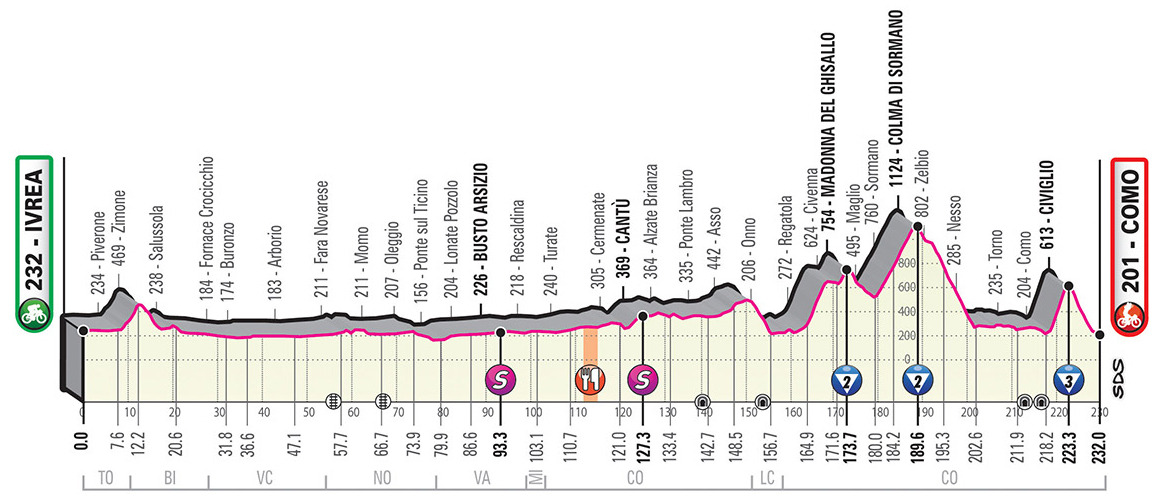
Does the finish look familiar? It’s a copycat stage of Il Lombardia via the Madonna del Ghisallo, Sormano (but the main road, not the wall) and then Civiglio, all together a good day for the breakaway.
Stage 16 – Tuesday 28 May

An Alpine anthology via Passo Gavia – the Cima Coppi for 2019 – and the Mortirolo and if there’s no summit finish many will have wooden legs for the finish in Ponte di Legno after this 226km marathon with 5,600m of vertical gain.
Stage 17 – Wednesday 29 May
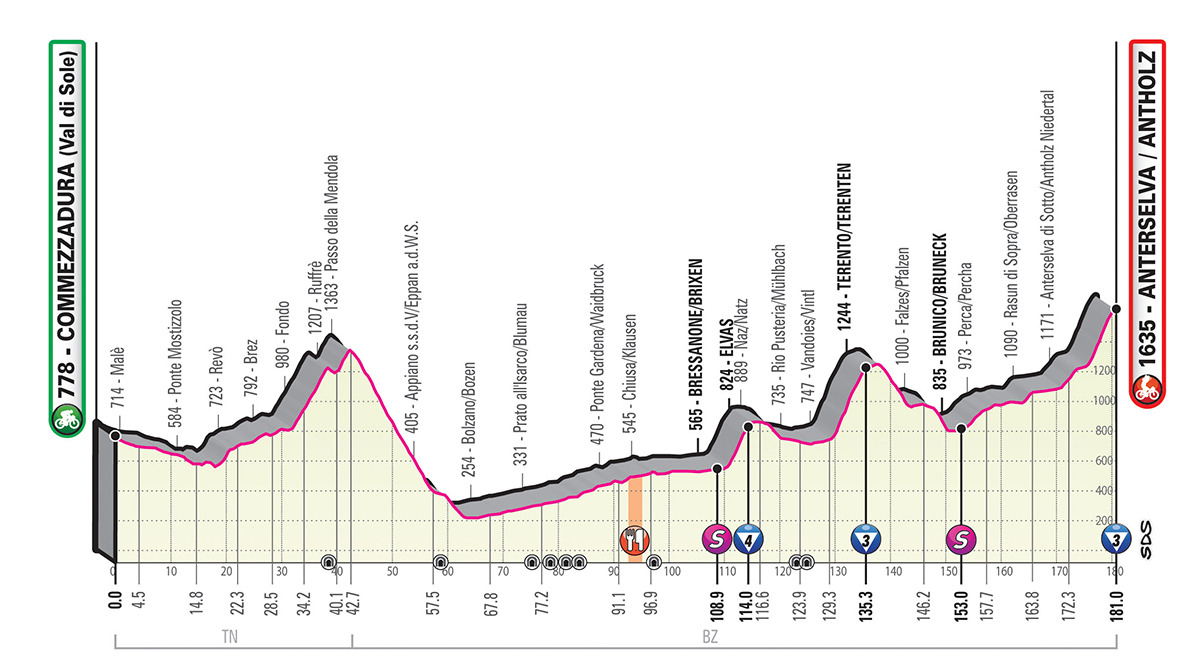
A day for the breakaway, the stage is Alpine but a pause between the high mountains and despite the profile, no summit finish really as it’s uphill but not up a sustained mountain pass.
Stage 18 – Thursday 30 May
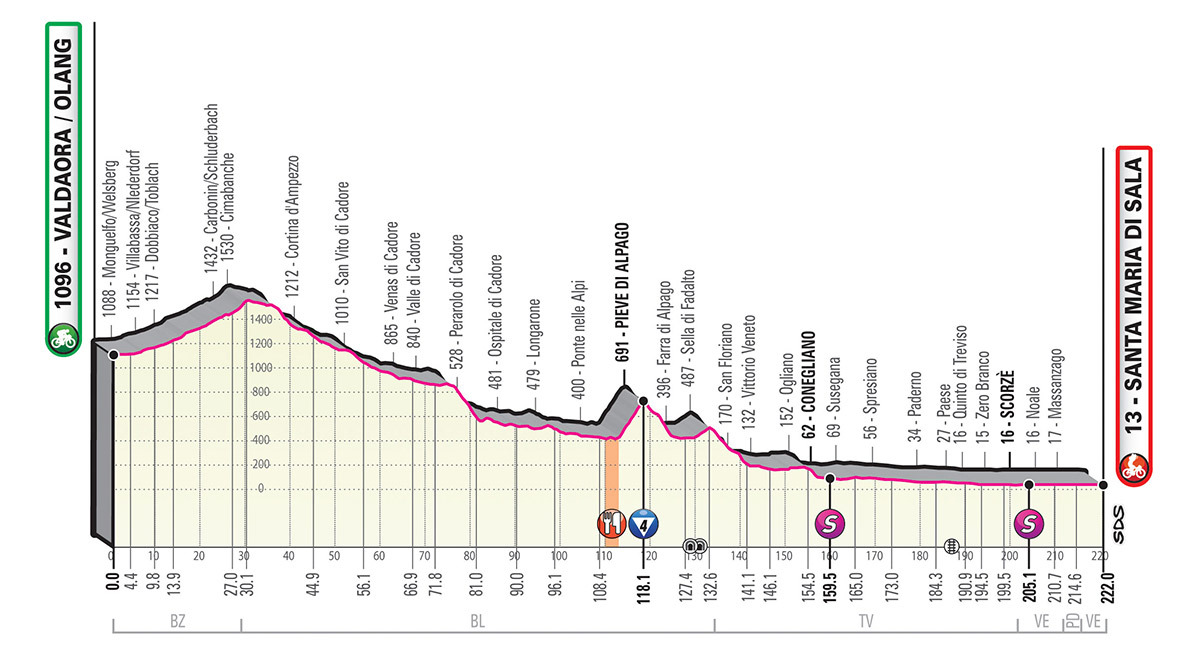
A quasi rest day for some and a last chance for the sprinters.
Stage 19 – Friday 31 May
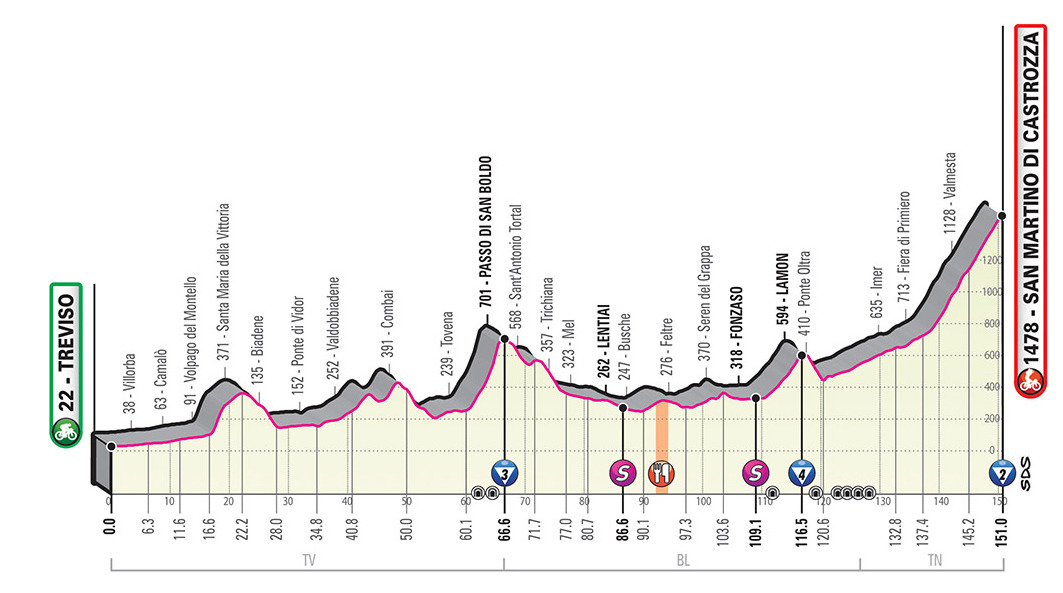
A mountain stage of sorts, first trip through the Passo San Boldo. Your normally go over most mountain passes but the San Boldo is a collection of hairpin tunnels, a hastily-built road to allow supplies to reach the front late during WW1 and locals, including women and children, were pressed into working day and night to build this. The comes the finish to San Martino, is it a summit finish? It’s the lower half of the Passo Rolle and for the most part a steady 6% slope which suits strong teams rather than flyweight climbers.
Stage 20 – Saturday 1 June
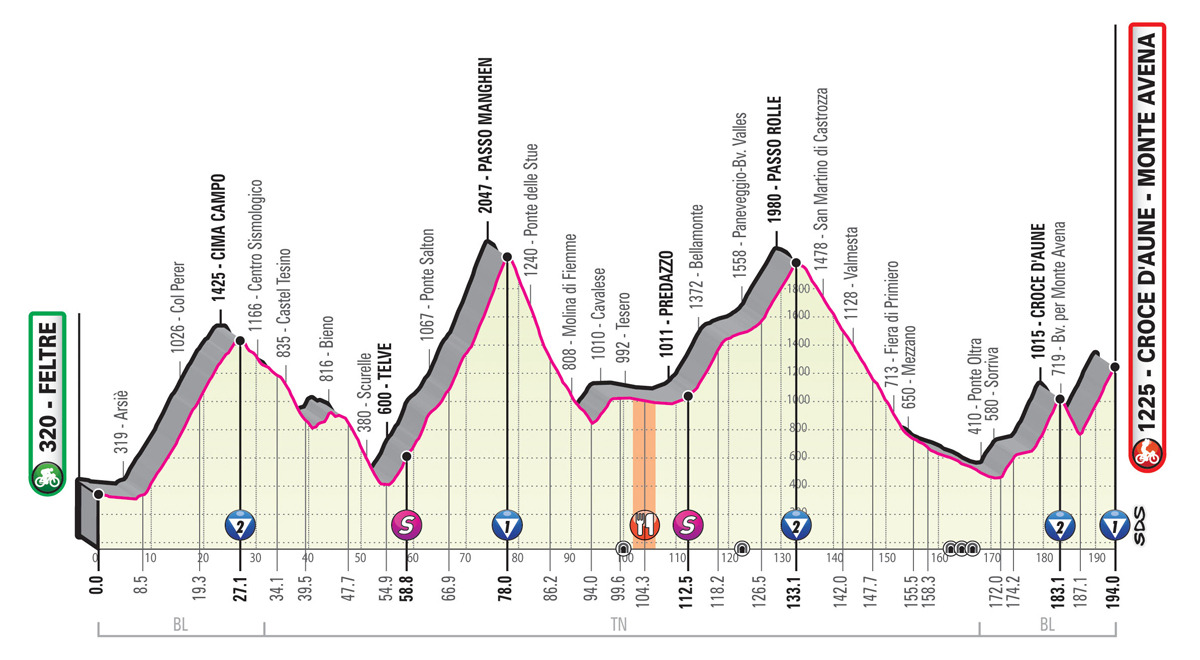
194km and a Dolomite roller-coaster with relentless climbing including a final ascent of 7km at 7%.
Stage 21 – Sunday 2 June

The race ends with a 17km time trial to Verona (not 15.6km as the profile suggests), a hill in the middle and a route used in the Giro time trials before as well as the World Championships before the finish in the Roman amphitheatre.
The Jerseys

There are four jerseys in the race: pink, cyclamen, blue and white.
Pink: the most famous one, the maglia rosa, it is awarded to the rider with the shortest overall time for all the stages added together. As such, they have covered the course faster than anyone else. It is pink because the race has always been organised by La Gazzetta Dello Sport, a newspaper printed on bright pink paper. It is sponsored by Enel, an energy company.
There are time bonuses available on all the stages except the time trials:
- 10-6-4 seconds for the first three riders respectively on each stage
- 3-2-1 seconds are available for the first three riders at the second of two intermediate “TV” sprints on each of the road stages
Cyclamen: the points competition. Riders pick up points at the intermediate sprints, the traguardi volanti marked as “TV” on the profiles above and at the finish line. The allocation of points depends on the stage in question, they are categorised with the typical sprint stages offering more points in a bid to place the purple-toned jersey on the shoulders of a sprinter who is handy with mental arithmetic. The maglia ciclamino is sponsored by Segafredo Zanetti, a brand of coffee.
- Category A+B stages (Stages 3,4,5,10,11,18) offer points for the first 15 riders at the finish: 50-35-25-18-14-12-10-8-7-6-5-4-3-2-1. For the TV there are points for the first eight: 20-12-8-6-4-3-2-1
- Category C stages: (Stages 2,6,7,8,12) offer points for the first 10: 25-18-12-8-6-5-4-3-2-1. For the TV there are points for the first five: 10-6-3-2-1
- Category D+E: (Stages 1,9,13,14,15,16,17,19,20,21) offer points for the first 10: 15-12-9-7-6-5-4-3-2-1
- For the TV there are points for the first eight: 12-8-6-5-4-3-2-1.
Blue: the mountains jersey. It is sponsored by Banca Mediolanum, a bank. Points are available atop the climbs and for 2019 the scale has been adjusted in favour of first rider over the climbs. There are five categories of climb:
- 10 fourth category climbs: the first three riders crossing the top of the climb win 3-2 and 1 points respectively
- 8 third category climbs: the first four riders over the top get 9-4-2-1 points
- 12 second category climbs: first six riders get 18-8-6-4-2-1 points
- 8 first category climbs: the first eight riders get 40-18-12-9-6-4-2-1 points
- CC or Cima Coppi: a special award, the “Coppi Summit” for the highest point of the race. This year it is the Passo Gavia on Stage 16. The first nine win 50-30-20-14-10-6-4-2-1 points
White: for the best young rider, this is awarded on the same basis as the pink jersey, except the rider must be born after 1 January 1994, ie aged 25 or under. It is sponsored by Euro Spin, a discount supermarket.
Obviously a rider can’t wear two jerseys at once, they’d get too hot. So if a rider leads several classifications, they take the most prestigious jersey for themselves and the number two ranked rider in the other competition gets to wear the other jersey. For example if a rider has both the pink jersey and the blue mountains jersey they’ll wear pink whilst whoever is second in the mountains jersey will sport blue jersey. In case you’re wondering the official hierarchy is pink > points > mountains > white.
There are also a host of daily prizes which keep the podium ceremonies going for some time like the Super Team, Winning Team, Fairplay, Breakaway and more.
The unmissable stages
Anything can happen during the Giro but there are some stages that matter more than others.
- Stage 7 – Friday 17 May: the L’Aquila finish, a mini classic
- Stage 9 – Sunday 19 May: the San Marino time trial, maybe not great TV but decisive
- Stage 12 – Thursday 23 May: the first mountain pass
- Stage 13 – Friday 24 May: the first summit finish and the cobbled wall in the finish
- Stage 14 – Saturday 25 May: a big mountain stage in the Aosta valley
- Stage 15 – Sunday 26 May: the Lombardia classic as a stage, all the breakaway specialists will go for it
- Stage 16 – : the Alps with the Gavia and Mortirolo
- Stage 20 – Saturday 1 June: the final mountain stage
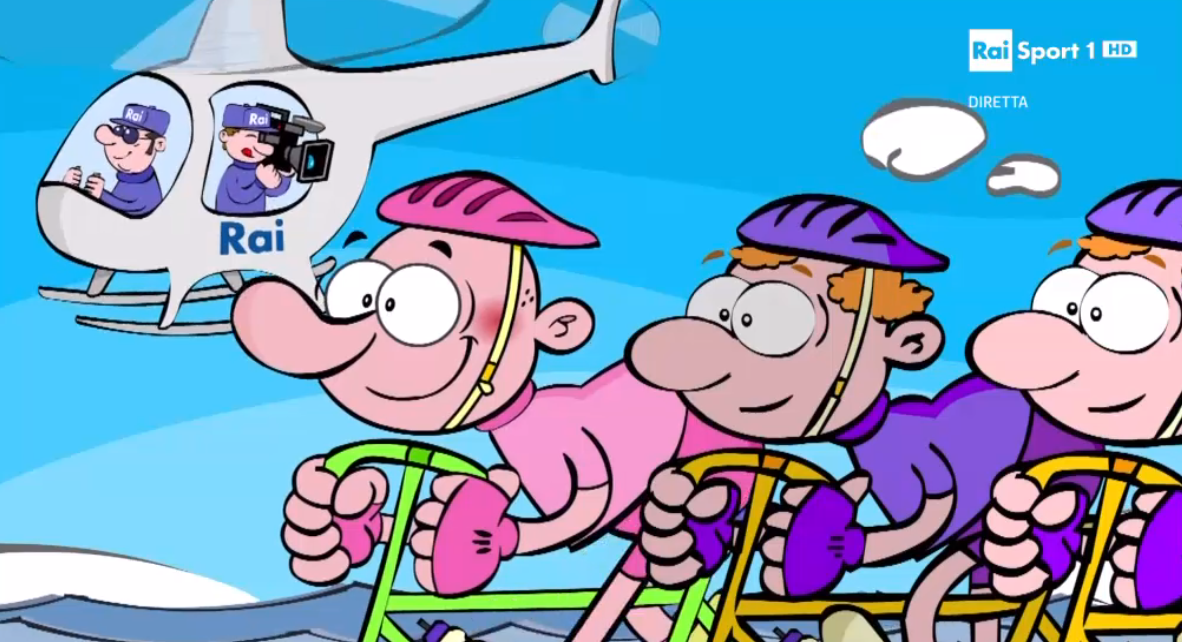
TV
Eurosport is covering the race across most of Europe plus Australia and New Zealand. It’s on L’Equipe TV in France and streaming via Fubo in the US and Dazn in Japan.
Italian host broadcaster RAI offers the best coverage with experienced commentators as well as roving reporters on motorbikes to add extra coverage, it’s on TV and radio in Italy and the geo-restricted website RAI.it. The timing varies but as a rule the live coverage begins at 2.45pm CET and the finish is expected for around 5.15pm CET each day.
Giro iCal
Click or save the ics / iCal / iCalendar file and you can import it into your electronic diary. One or two clicks and it’s on your iPhone / Outlook etc and for more info on how to put it in your diary, sync with Google etc, see the dedicated Giro ical page.

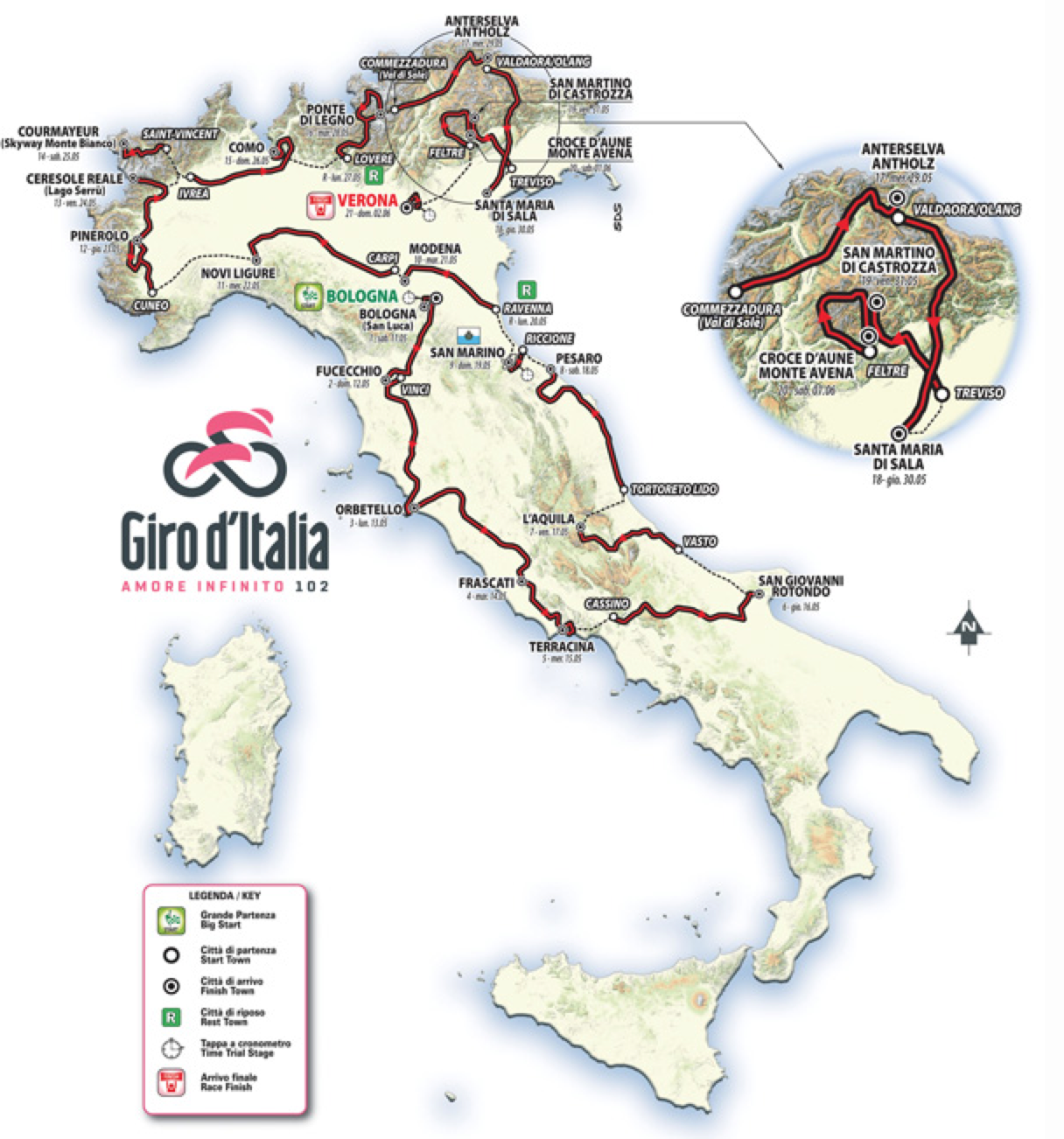
Thank you so much. Appreciate your work, the love and passion that went into it and your generous sharing. Was a pleasure to read, as always. Kind regards, Marc
Stage 12, not 13, has the cobbled wall at the end, right?
Yes, in Pinerolo. When you see the stages above it’s “Title, stage profile, description” in that order.
Yes, I saw. But in the unmissabble stages summary it’s listed on stage 13. Sorry for the nitpicking. Great overview and really appreciate your work and dedication!
Nice preview! Note on Stage 7’s description it’s GELATERIE, the plural of gelateria (GEL-a-tah-ree-ah)
My favorite time of the year, just picked up Bicisport’s Guida del Giro today after lunch in fact.
W Il Giro! Vai Nibali!
Better fix that. Did you catch the discussion about shoes and their origin on the cyclingtips podcast recently?
Nah, I can’t listen to podcasts – I find myself yelling at the speakers to get to their f–king point! Too many podcasts seem like a bunch of guys sitting around shooting the breeze with a beer or two. Great for them, but I find ’em boring as hell — little more than the equivalent of eavesdropping.
I think there’s a reason most of these guys deal with the written word instead of being radio or TV personalities.
Nice to find myself in full agreement and in perfect sync with Larry T for a chance! Guess I can’t escape or hide the fact that we are both old farts!
But at the same time I think it’s also a question of knowing how and when to listen to a podcast. It has always been a question of making your listening habit suit to the medium: whether it was from radio to TV, from 45 rpm singles to LP albums! When I have to do what a man’s gotta do (which is whatever his wife tells him must be done), I put on my headphones and listen half-heartedly; it helps time fly by and if and when someone says something interesting I prick up my ears and have a break from vacuuming the floor or whatever:-)
Is it just being an old-fart? I find it like being read to vs reading myself…I want to control the speed of the information flow. If I was driving a car (which for old-farts makes reading the printed word difficult, though it seems plenty of younger drivers do it all the time?) I might be willing to listen to a podcast just like an audio book, but otherwise it’s simply boring for the reasons I outlined earlier.
My guess is most of the regular commenters here would be good fun to sit around with drinks and shoot the breeze/argue with, but being forced to just listen to us blathering on would be excruciating torture. Someone who wants to skip my comments here can easily scroll down – as I have no doubt some do. With a podcast you’d have to listen to me!!! 🙂
+1 Larry
I’m with you. I want to read. Just give me the transcript of the podcast- it’ll take me 1/20th of the time to read, and then I can go for a ride.
Andrew – transcript? I think you just blurted out the ugly secret of these things – the journos don’t have to write anything. They get paid to yak and yuck it up instead. So much easier than typing something while being concerned about grammar and spelling, not to mention making a logical argument for their opinion, etc.
I’ve tried to listen to a few of them but the boredom factor is just too high. Makes me wonder about the generation of social media consumers with attention spans measured in seconds – do they play these while engaged in a couple of other activities at the same time? You know, “multitasking” which I think has been defined as doing a half-assed job of multiple things at the same time? Otherwise, how do they do it?
Stage 16 omg 😮
Quite, hope the weather is kind.
I know the route has been known for some time but it’s still exciting to review it in full like this. I hope the opening stages have some good breakaway action (a la 2016, when every stage seemed to be amazing). My feeling is that although there is a serious amount of climbing (and the cumulative exhaustion will hurt some, like Yates last year – even some of the cat 3 climbs look pretty monstrous), it will be a real struggle to eject the likes of dumoulin and roglic. it’s quite easy to argue that Lopez and yates are superior climbers (nibali too perhaps) but not by much. the sheer number of TT miles is going to tell. So, sounds ideal for bernal, but I think his inexperience will count against him – sky/ineos will be more confident after last year but I don’t think they will bring quite as strong a team this year.
I’m hoping for a slightly wacky race, with some inclement weather (but hopefully no cancelled stages/climbs) and some underdog victories. yates’ redemption would be a good story, but roglic looks like a top favourite right now (obvious observation is obvious).
Pink kit is washed and ironed, recipes for Italian dishes are ready and some of them tested, invitations from riding buddies with satellite TV or access to RAI via cable have arrived and been graciously accepted. Working hours so organized that I can watch from the start of the Eurosport coverage.
And last but not least, there are enough daylight hours to ride every evening after the day’s stage. April is the cruelest month, bu May is the happiest!
Stage 20 – a suiting celebartion of the quick release and Tulio. Disk brakes should be banned on this tage. Lovely climb by the way – especially from the southwest minor road, and i can see the they will do the the 3 cross pass from 2 different directions and continiue to the to the top of Avena for the 2nd time.
Like Svolte de Popoli on stage 7 the main road up to passo Croche d’Aune its a popular motor hill climb. When i climbed Crooche d’Aune on a Munich -Venice 2 week tour in 20115 they had prepped Croche d’Aune for hill climb – and when i did a Bolonga-Reiggo Clabria 3 week tour in 2016 i had to wait for them to clean up road furniture from the days hill climb for an hour late in the afternoon to be allowed to decent to Popoli.
I do disagree with your second sentence. Disk brakes are, like the quick release, innovation.
Yep, but the former are an innovation which makes things more complicated rather than simpler, and which is often far from being shared as a common platform – that’s not in Tullio Campagnolo’s spirit, I’d say.
+1 Innovation: change, alteration, revolution, upheaval, transformation, metamorphosis, reorganization, restructuring, rearrangement, recasting, remodelling, renovation or restyling.
Notice that IMPROVEMENT is not included in this list.
Lovely jerseys….
The “cyclamen” jersey is so awesome (and that’s a great word, too).
And ciclamino is an even nicer word 🙂
Thank you for this. I appreciate your passion and generosity.
Stage 2 is on Sunday, May 12, not May 11.
Cheers!
An excellent guide and a race I’m much looking forward too with a good and evenly spread field of favourites.
Great work for the greatest grand tour!
Just out of curiosity, why use 2 Sundays for time trials from a television point of view? On the other hand, fans are more rewarded with a spectacle on the weekend?
Stage 9 looks like a decision based on TV ratings. It’s the second-last round of Serie A that day and MotoGP is also on, so a good day to schedule the ITT on a day when everyone is watching something else. If they are smart they will be have scheduled the ITT to have the last hour when the action happens during the break between the 3pm and 6pm football matches.
The same can be said for Stage 15, have a boring day for the breakaway scheduled against the last day of the football season.
Stage 21 looks like a case where the sporting perspective and the TV perspective are aligned. Only the Tour has the Sprinters World Championship on the last day, a Giro final sprint stage is usually a quite disappointing affair contested by leftover rouleurs rather than proper sprinters – in 2015 it was even won by a breakaway. Holding an ITT stage gives them a chance of having a final stage with the GC still in play which viewers might tune into for the last hour.
Stage 21 seems like a problem which could be solved with the UCI allowing a bit more innovation in race formats. It should of course be trialled in a smaller race first, but I’d like to see a circuit set up to host a stage 21a ITT for just the top 20 plus any other riders who elect to race it (i.e. riders outside the top 20 hoping to move up and riders who want to target the stage win) at around lunchtime, a break in the early-mid afternoon (the circuit could hold an undercard race of some kind or a public ride) and then a sprint race later in the late afternoon with lots of points bonuses and cash primes on offer and no GC time gaps.
A good question, maybe they score well in Italy but we know the audience dips for the Tour de France TTs compared to a summit finish; especially as there’s no home candidate for the stage win as Nibali (and Aru were he riding) are expected to lose ground here.
Possibly it’s not bad for the crowds along the road? People are free during the weekend and a time trial is an event for half a day in a fixed physical location. A mountain stage attracts a lot of people as well but arguably less in total, less inside towns or cities and mostly focussed on specific parts of the col.
I remember the Tour start in Utrecht (bad example maybe, it being the TdF and in the city center) and there were so many people watching all day long, I presume more than the stage the next day.
I think it’s a solid decision based on audience facts rather than on speculation (although history doesn’t necessarily repeat itself). Having a quick look to the 2015-2018 viewing figures, it’s easy to notice that when ITTs are placed in Mon-Fri week days, they tend to obtain worse results than nearby working-day stages, whereas weekend ITTs normally score as different kind of stages, even mountain ones, would do in that same weekend of a different edition.
In other words, ITTs lose viewers during working days, but they seem to perform consistently as mountain stages when placed on weekends. The conclusion is just too obvious (besides, you’ve got more roadside spectators, indeed, and you can manage a simpler road closure).
For example, Valdobbiadene 2015 got 2.7 M viewers, exactly as Madonna di Campiglio the following day, or Oropa in 2017 (and way better than Bergamo), or, again Sappada in 2018 (the mighty Zoncolan reaching a very similar score of 2.8 M). Chianti 2016, a first weekend ITT, collected 2.3 spectators, which is exactly the same as Campitello Matese 2015 (and way better than S. Giorgio del Sannio), or Montevergine and Gran Sasso 2018, besides being very similar also to Peschici (2.2 M) or Blockhaus (2.4 M) in 2017.
Curiously, the Alpe di Siusi uphill ITT on 2016’s second weekend proved rather disappointing, just below the 2 M mark (but I must say that I don’t like uphill ITTs myself, either: however, I’d tend not to consider them as equal to flat or, better said, rolling ITTs).
OTOH, the Montefalco ITT in 2017, on the second Tuesday, was the least watched stage of that whole edition, and the worst second-week stage in terms of audience which I recorded for the 2015-2018 period.
The 2018 Rovereto ITT wasn’t as bad, being on the last Tuesday, but it was quite disapppointing nonetheless: it was the less watched third-week stage in the 2015-2018 period.
It’s also worth noting that while the last stage tends to be anticlimatic in audience term when it’s a traditional sprint stage, usually collecting some 1.7 M viewers (still way better than the meager 1 M which the Champs-Elysees often obtain in Italy or in Spain), that is a serious drop against the 3 M and over spectators who’re often watching the day before, instead the Milano ITT in 2017 was wacthed by nearly 3 M spectators, a stark contrast. The 2010 and 2011 finale with a last stage ITT had also been great in audience terms, if I’m not mistaken. Maybe it was the poor 2012 edition which didn’t exactly work and lead to a change in attitude.
Thanks for the data and analysis which explains the Sunday TTs. I would assume the biggest consideration and these numbers are for the Italian viewers, probably also largest contributor in terms of revenue?
Yes, Italian figures. Italian spectators were just a relative majority of global audience, broadly a third part of the total (it may vary depending on broadcasting deals). RAI, anyway, was granting big incomes, especially in very recent years. However, nowadays it’s harder to make esteems given that the Eurosport exclusive deals covering most markets hugely reduced global viewers (probably at least 2 M average viewers per stage were lost, that is, as much as the whole Italian reference mark). At the same time, it brought in big money, no doubt, as it’s easily seen in the startlist. The main setback was probably for researchers interested in this sort of data, becausr Eurosport isn’t publishing figures as regularly and consistently as public broadcaster (and many private ones, too) used to do.
Interesting details, thanks. On RAI vs Eurosport I have to confess to this year being much more interested in hooking up a cheap laptop we bought specifically for streaming (especially when in the US via pirate feeds) to our TV vs tuning in RAI2 or RAISport this year. Why? They’ve changed their broadcast lineup (for the worse) and we find Eurosport’s Luca DiGregorio and Riccardo Magrini better overall. So our RAI viewing numbers will be down, but of course they’ll never know the reason I guess? Dunno yet whether the replacement for Alessandra DiStefano on the Processo alla Tappa (post-race) show will be any good but RAI’s numbers might be down there in 2019 as well.
@Larry T
This really cracked me up, Larry. I’ve been emailing Prof. Van Reeth in Belgium (an academic expert who’s doing a great job on this whole subject) about 2019 Italian viewing figures which were actually falling down, and I had suggested precisely what you’re hinting at, however extreme may that sound. Anyway, furious fans apparently achieved a partial readjustment of the line-up, which was essentially due to political and personal reasons (old grudges and so): that is, Pancani was the main voice again for a couple of races at least. However, I expect the worst for the Giro.
They announced in Bicisport’s Guida del Giro that Andrea DeLuca would be doing the main RAI broadcasts with Alessandro Petacchi the technical comments while Francesco Pancani (who used to do the main broadcast) banished to a moto along with Marco Saligari. 🙁
Marco Franzelli(?) takes over the Processo alla Tappa from Alessandra DiStefano (who we really liked) along with Stefano Garzelli who comes across as a 60 watt bulb at best. They claim Davide Cassani and Beppe Conti will be there too to make up for it.
All this because Auro Bulbarelli takes over from Andrea Ferretti (who I never could figure out how the job became his, as he jumped from a moto reporter to the boss?) with Alessandra DiStefano the 2nd in command. The management can’t also be the on-air talent I guess though for me perhaps the best period was Bulbarelli/Cassani with DiStefano on the Processo and DeLuca on the moto.
L-B-L had Pancani doing the main stuff with Petacchi as sidekick – I hope perhaps they stay with this instead of what they’d planned when Bicisport went to print. Otherwise it’ll be a LOT more Eurosport for us!!!!
Thanks for the post. Eagerly waiting for the start. As per the roadbook Montoso is much harder at 8.8km @ 9.5%. Also the last TT is now 17 km long.
Good spot for the TT length change, will fix that.
Prepare for another departure en masse by the quick men in the second week.
This compromise by the course designers to front load the race with more-sprinter friendly stages in order to attract a good field is worth it, in my opinion.
We’ve got a good sprinter line-up where it looks like wins could be spread around. Even if DQS come with Bob Jungels and a five carriage sprint train for Viviani!
An interesting route with a bit of everything for everyone, TTs for Dumoulin, punchy finishes for Yates to pinch some time and the long Alpine stage for Nibali to work his magic.
Looks a pretty good route apart from there being too many flat stages and not enough stages for puncheurs, as has been the way in grand tours in recent years – no idea why, as puncheur-type stages are usually infinitely more entertaining (and the sprinters are either going to come or they’re not – taking a couple of stages away from them would make little or no difference to that).
My money is on Dumoulin (virtual money – I’m not even brave enough to back such an obvious choice) and I think it’ll be between him and the other top TT’er, Roglic.
its Itlay, dont trust the profile appart from the two stages in plains of Po (wouldt even trust the 2nd).
Good point.
In Italy, unlike in TdF, profiles are usually excellent. You need to properly read and interpret them, of course. In the first half, 4, 6, 7, 8 should be for the puncheurs, although some sprinter can earn ’em sweating hard. And I wouldn’t be confident about another couple of stages, in that same first half.
It seems it used to be a thing for the Giro in the 1970s and 80s to have whole surprise climbs in the Giro. This isn’t so today, the profiles and maps are generally accurate and if anything can over-exaggerate the course, for example they often state the max percentage of a climb but you’d need to visit with a theodolite to find it, it can hype up the climb a bit.
Yes, I maybe was a bit hasty in saying there weren’t enough puncheur stages. Thanks for the info. both and thanks to IR for the preview.
I’m a Froome supporter who also likes Nibali. I quite like Dumoulin and Roglic too so I’m in a quandary!
Roglic is supreme in one week stage races just now but seems to fade in Grand Tours. Dumoulin has kept a very low profile so little is known about his form. And Nibali may be looking at catch-up in the mountains because of the large amount of TT miles, not that he’s bad against the clock.
What’s Sivakov like at TTS?!
LMGTFY https://www.procyclingstats.com/rider.php?id=pavel-sivakov&p=results&xseason=&sort=date&race=&km1=&km2=&limit=100&page=0&topx=&type_3=1&continent=&pnts=&level=&rnk=&filter=Filter&morefilters=0
I always enjoy the little gems of word play in your posts but wouldn’t normally comment.
“On inspection Montalbano”, however…
+1, though far too cosmopolitan for me – had to google that.
I love bike riding.
I wish do racing in grand fondo Italy and grand fondo Greecc.
Is there a nod to Pantani on stage 10? There doesn’t have to be, but it is 20 years since he was infamously kicked off the Giro for being a fraction over 50% on the hematocrit test. Seems an odd nod to him if it is. “20 years ago we kicked your favourite son off the Giro, and just to remind you of the fact we’re holding a stage in your town!”
They really seem to be oscillating between long and short stages too. Will be interesting to see if they ignite the race or whether teams will not want to lay it all out there on the shorter stages. Froome sort of turned the tables on that one. I don’t think we’ll see his gambit again this year.
Why should Stage 10 have anything to do with Marco Pantani? Totally flat from Ravenna to Modena, it’s more like a “Motor Valley” stage IMHO.
It passes near the Mercatone Uno HQ, who sponsored Pantani and they have a giant memorial to him outside the building.
Yes, I’ve seen the Mercatone HQ as you can see here https://cycleitalia.blogspot.com/2017/07/la-valorosa-2017.html but I heard recently they’re bankrupt and the Pantani memorabilia is in danger of being sold off to private collectors as part of the legal proceedings, so not much to celebrate.
Anyway, Cesenatico was The Pirate’s hometown but Stage 10’s start in Ravenna is 30 kms north. Finally, I don’t think too many cycling fans of any nationality (let alone RCS) want to commemorate the year The Pirate was kicked out of the Giro under what many still consider some dodgy circumstances.
That’s kind of the weird thing though. It just sort of seems insensitive, even crass, like they’re not really acknowledging him, but just happened to be cycling through his home town on the 20th anniversary of the event which sent his life into a downward spiral which resulted in his accidental early death.
If it was 2018, it could be deemed a celebration of his win….but not 2019….
I was hoping that actually there was something poignant about it, but nope.
Great work, the dates need a bit of tidying up on the stages though – Stage 21 is listed on Sunday 27th May rather than 2nd June, Stage 2 is the 11th May instead of 12th – possibly others but those are the ones that leapt out at me!
Excited for the first (and often best…) grand tour of the season, unfortunate that Bernal is going to miss it.
You mention the Colle del Nivolet on stage 13, is the Giro going up it on this stage?
About 3/4 of the way up but not to the pass at the top.
Does the three time trials not offering points for the points classification?
Yes, there are, an omission on my part as they are labelled “category E” stages and count too. Fixed now.
seeing the profile makes it easy to understand why Sam Bennett is so peed off about missing out…
It seems to me that having just the one TT would have offered a much better balance between Yates/Nibali/Lopez and Roglic/Dumoulin. With the two stages plus prologue I cant see anyone touching Roglic, unless Dumoulin has been hiding some form under a bushel…
….or Simon Yates TT is anything like his Paris-Nice effort?
the other interesting ride in that TT was Jungels… really wouldn’t have expected Yates to put 39 secs into him.. it wasn’t particularly hilly (even Chaves was only 5 secs back)
I’ve always liked the Giro trophies, and now I realise there’s another benefit to its perennially spiralling design:-
This year’s winner is added at the top and so previous winners run back down around the spiral so you wonder what dodgy winners are now nicely out of sight…
And how nice it is that the most dodgy name of ’em all appears nowhere on the Trofeo Senza Fine!!!
W Il Giro!
Thanks for this guide and more generally this blog.
Could Stage 10, short and flat, be interesting in case of wind? It’s after a rest day, some could have heavy legs and/or be caught off-guard… Or am I dreaming too much?
It’s just not a windy part of Italy normally. But surprises can happen and the forecast for the next week in Italy doesn’t look great, maybe the weather will bring a surprise? It did have a big effect in 2010, breakaways forming in the downpours etc. If not Stage 10 will be a straight sprint and a popular day for the visiting press pack given it’s so close to lots of Italian food sources.
I don’t live in this region of Italy but I think a big wind roaring up or down this valley like you’d find in northern Europe is unlikely. You should probably add WORLD FAMOUS Italian food sources since not all Italians subsist on Parmigiano-Reggiano. Aceto Balsamico di Modena and Prosciutto di Parma washed down with Lambrusco 🙂
One of my favorite features of Bicisport’s Guida del Giro is their gastronomic guide that appears just below the historical bits relevant to the day’s stage. Stage 1’s all about tagliatelle al ragu, perhaps better known elsewhere as spaghetti bolognese. But here it’s the real thing and once you’ve enjoyed it, you’ll never look at a plate of “spag bol” the same way again!
Hi,
Great work! Curious though, as to whether the KOM points are correct. Some Italian sites such as this have different KOM points, but they may simply be taken from last year’s race. Do you have a link to this year’s rules? Haven’t been able to find them anywhere.
https://www.oasport.it/2019/05/giro-ditalia-2019-il-regolamento-della-corsa-rosa-secondi-di-abbuono-tempo-massimo-e-traguardi-volanti/
That’s last year’s scale. I don’t have a link to the rules for this year… but have the rulebook itself.
Just want to say, thanks for all your work on this for all of us, it’s totally appreciated. I miss the days when inrng was the first website of the day to look at for most of the racing year — but totally get its a massive effort. So, many thanks for keeping it going for the big races for us.
Thanks, all feedback good and bad (hopefully constructive but doesn’t have to be) is welcome.
I am very sad to hear that Alessandro DiStefano will no longer be doing the Processo alla Tappa. She was both knowledgable and entertaining. Also, when she really got going, her machine-gun delivery made listening a solid challenge for my somewhat rusty Italian.
Allow me to disagree as long as “knowledgeable” is concerned. And “entertaining” is more about personal POVs. However, it was great to have a woman in the mix with a leading role.
As inrng points out, stage 15 is a Giro di Lombardia copycat, as should have been the Bergamo stage in 2017, wasn’t it because the organisers finally made it way milder (as they did with several other stages that year) in order to tilt the balance against the climbers.
What isn’t as manifest is that also stage 5 is a nod to another historical Italian Classic, not comparable to a Monument like the Lombardia, surely, yet a great race which can be traced back to the 30s of the 20th century: the Giro del Lazio. With a story of funny and less funny name changes, from the Giro delle Quattro Province to GP Littoria, finally to the pompous Roma Maxima in its most recent marketing incarnation, it’s got a story of great winners and relatively early international participation, since the late 60s, just a handful of years later than the Liège (long a local affair). Bartali, Magni, Baldini, Bitossi, Gimondi, De Vlaeminck, Moser, Baronchelli, Zimmermann, Mottet, Bugno, Pascal Richard, Tafi, Bettini, Bartoli, Flecha, Pozzato, Valverde top a list of often prestigious podia.
It more or less died in 2008 before resurrecting for a mere two editions which nonetheless granted the fans a couple of memorable moments: it provided Pozzato with one of the best victory salute photos ever, the Colosseo as the perfect background (if it wasn’t for a devilish detail – Kadri had already won from a break), and, the following year, it showed everybody that Valverde could win a race being utterly aggressive and going alone from far our. Sometimes.
The race was probably condemned to die by the existence of the GF Roma Campagnolo, held on a similar route, and drawing an impressive amount of resources, especially public ones, which obviously wouldn’t be available anymore to support the pro cycling race.
The couple of climbs with which stage 5 starts, Rocca Priora and Rocca di Papa, were a traditional landmark of the race (and the GF as well), although the second has been shortened a bit, as it used to rise up to Campi di Annibale. It’s significant that they enabled attacks from far, and, when used as a finale, they selected a top-ten of GC men and climbers, despite their apparent lack of a truly Alpine profile.
However, what I find more interesting come the Giro is the example provided by the editions of the first half of the years 2000s (until 2005, which was made easier, before three editions which ended uphill): modern cycling, by all means, and the course, 200 km long, presented no major obstacle but that couplet of climbs. They were placed 80 to 60 kms from the finish line, and the final 50 kms were totally flat: yet, the race granted a good selection, often with a group of twenty reaching the line more or less fractioned and the rest some 4 minutes behind. The winning group was typically made by a good mix of classics men (Flecha, Bartoli, Bettini, Rebellin, Bortolami…) and GT men (Simoni, Ullrich, Basso, Savoldelli, Bruseghin, Frigo…).
Of course, a stage of a GT is a whole different affair, the most probable result, and by far, is a bunch sprint after the break which goes on those climbs is reeled in. The climbs are also further from the line. Teams will be fresh and sprinters motivated to grab their occasion.
That said, no doubt that anybody who should be taken off-guard might end up living a nightmare day. And if it was some big name, be it a sprinter or a GC man, the race situation might unleash some crazy forcing on the front which would make everything even more complicated, even more so given that the stage is quite short. Was it a later stage, it could even become a “Formigal stage”.
All in all, I don’t really think that something serious is bound to happen, but, perhaps, I would have included this one, too, among the possible ambush stages (CN wouldn’t agree). After all, if an ambush is too obvious, it’s less of an ambush!
Great stuff, grazie! Someone claimed the Giro di Lazio route used parts of the old Appian Way. We lived in the Eternal City for a time awhile back and used to bounce around on MTB’s out there as well as riding one edition of the GF Campagnolo and watching Roma Maxima along with the Under-23 race they used to run (May 1st?) while there. Those uneven stone blocks make the pave of Paris-Roubaix look like a newly paved highway, so it’s hard for me to imagine a road bike race over them. Do you know anything about this?
True, but it was more about its most urban section, which is in fact called “via Appia Antica”, as well, but which is paved in milder “porfido” rather with the stone blocks right from Ancient Rome you can still find elsewhere.